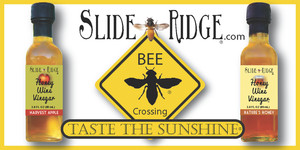18 Jan Fri 2013
Winter Bee Update
It is cold at the Slide Ridge Honey House this week, really cold.
 Temperatures have been as low as -15-20 degree F over the last week or so. The wild turkeys are out and wandering through town, but the bees sure don’t fly. So, what does an apiary operation do over the winter? Is it vacation time?
Temperatures have been as low as -15-20 degree F over the last week or so. The wild turkeys are out and wandering through town, but the bees sure don’t fly. So, what does an apiary operation do over the winter? Is it vacation time?
Not hardly!
With the winter temperatures we frequently see in Northern Utah, we don’t keep our bees in the mountains. It would be impossible to get them out through the snow for our pollination runs, for one thing. Plus, the extreme cold would add stress to the hives and deplete their resources. So, each fall, we load up our bees and haul them to a more temperate location where they can winter with less stress. We put pollen patties in each hive as we tuck them in for the winter as insurance for a strong hive in the spring. We usually get the last of the bees out of Northern Utah after the fields freeze, but before the snow really flies (December).
The trick is, spring comes early when you are on the pollination circuit! Our hives have been at their winter grounds for only a few weeks, and now we are heading down to check bee and hive health and make sure they are all ready to start moving into the pollination fields in a couple weeks. We made pollen patties yesterday, using a cement mixer in the honey house. We’ll haul the patties down with us and add them to any hive that looks like it needs a little extra strength. If the weather looks warm enough, we may even put out some of our custom feeding troughs with corn syrup to make sure there is plenty for the bees to eat.
While we are with the bees, we will check and treat for mites and other pests or hive issues. We have developed a series of natural remedies over the years that help keep our bees healthy without exposure to poisons or other dangerous chemicals. If necessary, we will apply our treatments where they will do the most good. All this, in preparation for the beginning of our pollination runs. Before we leave, we will actually stack the hives on the trailers in preparation for the first load.
With such a short winter break, we are already looking at the spring marathon. It starts with pollination, and then moves right in to queen breeding and hive nuc’ing, finally ending when we can place our hives back out to their summer honey collection locations.
We love our bees, and our hives, and we love the life of the beekeeper, but it sure is a lot of work!

